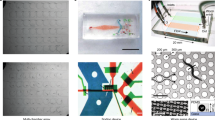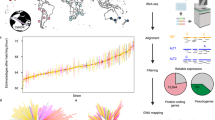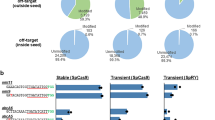Abstract
Genes linked to human cancers often function in evolutionary conserved pathways, and research in C. elegans has been instrumental in dissecting some of the pathways affected, such as apoptosis and Ras signalling. The advent of RNA interference (RNAi) technology has allowed high-throughput loss-of-function analyses of C. elegans gene functions. Here we review some of the most recent genome-wide RNAi screens that have been conducted and discuss their impact on cancer research and possibilities for future screens. We also show that genes causally implicated in human cancers are significantly more likely to have a C. elegans homologue than average, validating the use of C. elegans as a cancer gene discovery platform. We foresee that genome-wide RNAi screens in C. elegans will continue to be productive in identifying new cancer gene candidates and will provide further insights into cancer gene functions.
This is a preview of subscription content, access via your institution
Access options
Subscribe to this journal
Receive 50 print issues and online access
$259.00 per year
only $5.18 per issue
Buy this article
- Purchase on Springer Link
- Instant access to full article PDF
Prices may be subject to local taxes which are calculated during checkout

Similar content being viewed by others
References
Berry LW, Westlund B and Schedl T . (1997). Development, 124, 925–936.
Boulton SJ, Martin JS, Polanowska J, Hill DE, Gartner A and Vidal M . (2004). Curr. Biol., 14, 33–39.
Ceol CJ and Horvitz HR . (2001). Mol. Cell, 7, 461–473.
de Jager M and Kanaar R . (2002). Genes Dev., 16, 2173–2178.
Derry WB, Putzke AP and Rothman JH . (2001). Science, 294, 591–595.
Ellis HM and Horvitz HR . (1986). Cell, 44, 817–829.
Fay DS and Han M . (2000). Genesis, 26, 279–284.
Feng Q and Zhang Y . (2003). Curr. Top. Microbiol. Immunol., 274, 269–290.
Fire A, Xu S, Montgomery MK, Kostas SA, Driver SE and Mello CC . (1998). Nature, 391, 806–811.
Fraser AG, Kamath RS, Zipperlen P, Martinez-Campos M, Sohrmann M and Ahringer J . (2000). Nature, 408, 325–330.
Futreal PA, Coin L, Marshall M, Down T, Hubbard T, Wooster R, Rahman N and Stratton MR . (2004). Nat. Rev. Cancer, 4, 177–183.
Gumienny TL, Lambie E, Hartwieg E, Horvitz HR and Hengartner MO . (1999). Development, 126, 1011–1022.
Hanahan D and Weinberg RA . (2000). Cell, 100, 57–70.
Harbour JW and Dean DC . (2000). Curr. Opin. Cell Biol., 12, 685–689.
Harris TW, Chen N, Cunningham F, Tello-Ruiz M, Antoshechkin I, Bastiani C, Bieri T, Blasiar D, Bradnam K, Chan J, Chen CK, Chen WJ, Davis P, Kenny E, Kishore R, Lawson D, Lee R, Muller HM, Nakamura C, Ozersky P, Petcherski A, Rogers A, Sabo A, Schwarz EM, Van Auken K, Wang Q, Durbin R, Spieth J, Sternberg PW and Stein LD . (2004). Nucleic. Acids Res., 32 (database issue), D411–D417.
Hengartner MO, Ellis RE and Horvitz HR . (1992). Nature, 356, 494–499.
Kamath RS, Fraser AG, Dong Y, Poulin G, Durbin R, Gotta M, Kanapin A, Le Bot N, Moreno S, Sohrmann M, Welchman DP, Zipperlen P and Ahringer J . (2003). Nature, 421, 231–237.
Kornfeld K, Hom DB and Horvitz HR . (1995). Cell, 83, 903–913.
Kostic I, Li S and Roy R . (2003). Dev. Biol., 263, 242–252.
Lettre G, Kritikou EA, Jaeggi M, Calixto A, Fraser AG, Kamath RS, Ahringer J and Hengartner MO . (2004). Cell Death Differ., in press.
Liu QA and Hengartner MO . (1999). Ann. N. Y. Acad. Sci., 887, 92–104.
Lu X and Horvitz HR . (1998). Cell, 95, 981–991.
Moghal N and Sternberg PW . (2003). Exp. Cell Res., 284, 150–159.
Nollen EA, Garcia SM, van Haaften G, Kim S, Chavez A, Morimoto RI and Plasterk RH . (2004). Proc. Natl. Acad. Sci. USA, 101, 6403–6408.
Parrish JZ and Xue D . (2003). Mol. Cell, 11, 987–996.
Pothof J, van Haaften G, Thijssen K, Kamath RS, Fraser AG, Ahringer J, Plasterk RH and Tijsterman M . (2003). Genes Dev., 17, 443–448.
Schumacher B, Hofmann K, Boulton S and Gartner A . (2001). Curr. Biol., 11, 1722–1727.
Sherwood DR and Sternberg PW . (2003). Dev. Cell, 5, 21–31.
Sieburth DS, Sun Q and Han M . (1998). Cell, 94, 119–130.
Solari F and Ahringer J . (2000). Curr. Biol., 10, 223–226.
Sternberg PW and Han M . (1998). Trends Genet., 14, 466–472.
Sternberg PW . (2001). Cell, 105, 173–176.
Sulston JE and Horvitz HR . (1977). Dev. Biol., 56, 110–156.
Sundaram M and Han M . (1995). Cell, 83, 889–901.
Sung P, Krejci L, Van Komen S and Sehorn MG . (2003). J. Biol. Chem., 278, 42729–42732.
Tabara H, Grishok A and Mello CC . (1998). Science, 282, 430–431.
Tan PB and Kim SK . (1999). Trends Genet., 15, 145–149.
Tijsterman M, Pothof J and Plasterk RH . (2002). Genetics, 161, 651–660.
Timmons L and Fire A . (1998). Nature, 395, 854.
Van Haaften et al., Personal communication.
von Zelewsky T, Palladino F, Brunschwig K, Tobler H, Hajnal A and Muller F . (2000). Development, 127, 5277–5284.
Wassarman DA, Therrien M and Rubin GM . (1995). Curr. Opin. Genet. Dev., 5, 44–50.
Wong AK, Pero R, Ormonde PA, Tavtigian SV and Bartel PL . (1997). J. Biol. Chem., 272, 31941–31944.
Acknowledgements
We are extremely grateful to Peter Askjaer, Guillaume Lettre, and David Welchman for providing pictures for Figures 1A, B, 1C–F, and 1G–H, respectively. We also thank David Rivers, Nathalie Le Bot, and Verena Wolfram for their helpful comments on the manuscript. GP is supported by the Wellcome Trust and JA is a Wellcome Trust Senior Research Fellow (054523).
Author information
Authors and Affiliations
Corresponding author
Rights and permissions
About this article
Cite this article
Poulin, G., Nandakumar, R. & Ahringer, J. Genome-wide RNAi screens in Caenorhabditis elegans: impact on cancer research. Oncogene 23, 8340–8345 (2004). https://doi.org/10.1038/sj.onc.1208010
Published:
Issue Date:
DOI: https://doi.org/10.1038/sj.onc.1208010
Keywords
This article is cited by
-
Recent Advances in Microfluidic-Based Microphysiological Systems
BioChip Journal (2022)
-
Tumour-related microRNAs functions in Caenorhabditis elegans
Oncogene (2006)
-
Chemistry-to-gene screens in Caenorhabditis elegans
Nature Reviews Drug Discovery (2005)
-
RNA interference-based functional genomics in cancer research – an introduction
Oncogene (2004)



